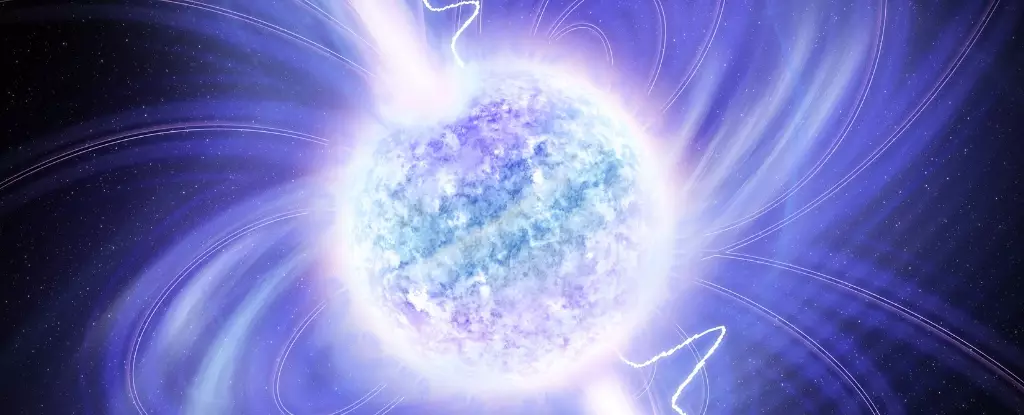Pulsars are extraordinary celestial objects that have captivated astronomers and enthusiasts alike since their discovery. Functioning as cosmic lighthouses, these rapidly spinning neutron stars emit beams of radio waves, creating periodic pulses detected from Earth. This beacon-like behavior stems from their incredible rotational speeds, often completing a full rotation in mere seconds. However, the recent discovery of a slower pulsar, named ASKAP J1839-0756, challenges established notions about these enigmatic entities, pushing the boundaries of our understanding of stellar evolution and behavior.
The spin of ASKAP J1839-0756 is astonishing—it rotates every 6.5 hours, a stark contrast to the vibrant activity typically associated with pulsars. Unearthed using the Australia Square Kilometre Array Pathfinder (ASKAP) radio telescope in Western Australia, this object emerged unexpectedly during routine observations. Initially distinguished by its rapid fading bursts of radio emissions, ASKAP J1839-0756 presented itself as an anomalous cosmic phenomenon, intriguing researchers desperate to unveil its nature.
What is remarkable about ASKAP J1839-0756 is its emission of periodic radio pulses, which according to existing neutron star theories, shouldn’t be possible at such a leisurely rotational pace. Standard models predict that a neutron star is expected to cease its pulsating behavior when its spin decelerates beyond approximately one rotation per minute. Yet, ASKAP J1839-0756 defies this understanding, shining with radiance in a manner previously deemed impossible.
To decode the enigmatic nature of ASKAP J1839-0756, researchers employed a multi-faceted observational strategy. Initial detections were followed by extensive scrutiny involving multiple telescopes, including the Australia Telescope Compact Array and the MeerKAT radio telescope in South Africa. Through a combination of these advanced instruments, astronomers confirmed the periodicity of the pulses separating within the span of 6.5 hours.
This meticulous approach while creating a holistic view of ASKAP J1839-0756 also revealed the presence of interpulses—faint emissions detected approximately 3.2 hours after the primary pulse. This finding raises intriguing questions about the orientation of the pulsar’s magnetic axes and its potential influence on radiation patterns, providing valuable insights into the gravitational and magnetic properties of neutron stars.
Challenging Conventional Theories
The existence of ASKAP J1839-0756 ignites critical discussions about neutron stars’ mechanics and their inability to sustain radio emissions at reduced rotational speeds. Traditional theories will need to be reevaluated to accommodate the existence of this slow-spinning cosmic lighthouse. Could it indeed be a magnetar—a type of neutron star characterized by outstanding magnetic fields? Magnetars are known to emit radiation via different mechanics, yet conventionality suggests that their pulsation periods rarely extend into the hours. ASKAP J1839-0756 stands as an anomaly against this backdrop.
Interestingly, the only magnetar similar to ASKAP J1839-0756 is 1E 161348-5055, which emits X-rays but not radio pulses, underscoring the unique nature of this discovery. While magnetars could provide a plausible explanation, they primarily operate under conditions not fully aligned with what has been observed. Could ASKAP J1839-0756 be an entirely new astronomical phenomenon or even a white dwarf? This notion encounters yet another hurdle, as no similar isolated white dwarfs have been identified emitting radio pulses, leading to a hefty dose of speculation among scientists.
Implications for Future Research
The revelation of ASKAP J1839-0756 calls into question the rigid confines of current pulsing eclipses in neutron star behaviors, providing a fresh prompt for astronomers to widen their horizons. What methodologies should be employed to pursue deeper insights into the characteristics of slow spinning star systems? This discovery serves as a catalyst for stimulating new observational campaigns that may uncover critical information about the life cycle of stellar objects and their ultimate fates.
Undoubtedly, ASKAP J1839-0756 marks a transformative point in astronomy, prompting astronomers to rethink the phenomena surrounding neutron stars. As we continue to observe and analyze this mysterious object, more secrets concerning the cosmic fabric of our universe are bound to surface, enriching our understanding of stellar mechanics and expanding the classical definitions within astrophysics.
The cosmos remains a realm of boundless intrigue, and with the advent of discoveries like ASKAP J1839-0756, it becomes clear that the universe spontaneously surprises us, revealing complexities beyond our imagination. It serves to remind us that in the vast expanse of space, much remains unknown, beckoning for exploration and discovery.


Leave a Reply